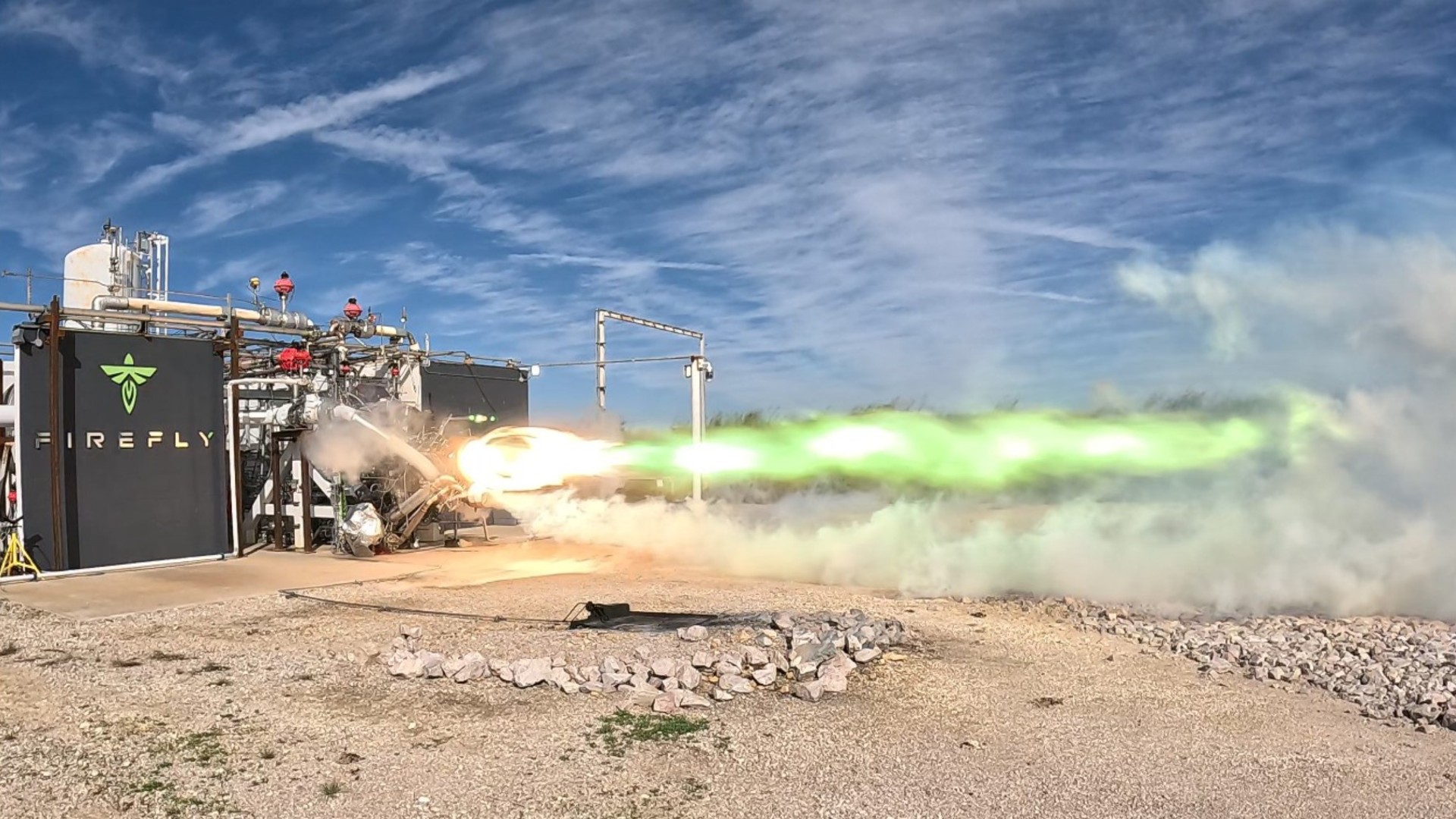Firefly Aerospace's new rocket engine spouts green flames in 1st 'hot fire' test (photo)
The Miranda engine will replace its Russian-built predecessor on the upcoming Antares 330 rocket.

Firefly Aerospace conducted the first hot fire test of its new Miranda rocket engine, producing a massive plume of green flames.
Firefly's Miranda engine is slated to be used on the first stage of Northrop Grumman's Antares 330 rocket as well as the Medium Launch Vehicle (MLV) the two companies are developing together. The Antares 330 rocket is designed to carry more than 22,000 lbs of cargo to the International Space Station (10,000 kg), while the MLV will be able to loft 35,000 lbs (16,000 kg) of payload to low Earth orbit.
The Antares 330/MLV is slated to replace the Antares 230, which used Russian rocket engines and Ukrainian-built first stages. Due to Russia's ongoing invasion of Ukraine, Northrop Grumman announced in 2022 that it would develop a fully domestic version of the rocket along with the new MLV. The first flight of the Antares 330 is currently projected to take place in mid-2025, while the MLV's maiden voyage should follow in late 2025.
Related: Northrop Grumman picks Firefly to replace Russian engines on Antares rocket
Northrop Grumman leadership is already touting the new rocket as a game-changer when it comes to rapid launch capabilities, a feat Firefly Aerospace has already proven capable of.
"Together, we have developed a solution that will help change the trajectory of space launch, from commercial to national security and civil space," said Scott Lehr, vice president of launch and missile defense systems at Northrop Grumman, in a press statement. "Upgrading the first stage of Antares in parallel with developing the Medium Launch Vehicle enables our two companies to bring a new launch vehicle to market more rapidly while also reducing risk in the design process."
In September 2023, Firefly Aerospace launched the "Victus Nox" mission on behalf of the U.S. Space Force that set a new responsive launch record by putting a payload in orbit with just 27 hours of notice.
Get the Space.com Newsletter
Breaking space news, the latest updates on rocket launches, skywatching events and more!
Firefly is also developing a moon lander called the Blue Ghost. NASA tapped the lander for a scientific mission to the lunar far side in 2026.
Firefly happens to share its name with a cult favorite TV series about a ragtag crew of mercenaries traveling through space together. The name of its new engine, Miranda, happens to also be the name of planet that plays a central role in the lore of the "Firefly" franchise.
Firefly Aerospace's previous Alpha launch vehicle was powered by the Reaver engine; "Reavers" just happen to also be one of the main antagonists in the "Firefly" TV series and spin-off film, "Serenity."
Join our Space Forums to keep talking space on the latest missions, night sky and more! And if you have a news tip, correction or comment, let us know at: community@space.com.

Brett is curious about emerging aerospace technologies, alternative launch concepts, military space developments and uncrewed aircraft systems. Brett's work has appeared on Scientific American, The War Zone, Popular Science, the History Channel, Science Discovery and more. Brett has English degrees from Clemson University and the University of North Carolina at Charlotte. In his free time, Brett enjoys skywatching throughout the dark skies of the Appalachian mountains.
-
Brent.Allsop Yes. There must be something making the methane and oxygen burn green. What is that?Reply -
eason Reply
I think it is similar to TEA-TEB, which is a pyrophoric mixture used as an ignition fluid in rocket engines.Brent.Allsop said:Yes. There must be something making the methane and oxygen burn green. What is that?









